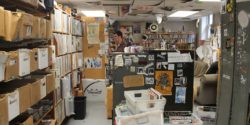With the school year drawing to a close, college radio news is sparse, as students finish up school work and cram for final exams. Since it was a slow week, it provided the perfect opportunity for me to finally view an episode of the new Netflix series Dear White People. With a college radio DJ protagonist, the show attracted my attention, as I am always interested in seeing how college radio is portrayed on TV.
Set at Winchester University, a fictional Ivy League school, the show tackles the complexities of racism from multiple perspectives, most notably from the point of view of media studies major/college radio DJ Samantha White. She hosts a show at her college radio station called “Dear White People,” in which she delves into racism and racial politics on campus. Those themes have already been covered by other reviews of the series, so I’ll turn my attention to the college radio aspects of the show. As a fan of college radio culture, I was very curious to see how the Winchester College radio station compared with the reality of college radio, so of course I was looking forward to scrutinizing the college radio scenes.
About two minutes in to the first episode, a shot zooms in on Samantha at her college radio station and a narrator proclaims, “Sam had enough and took to Winchester’s syndicated student radio station.” That line was my first clue that not every college radio detail would be right, as the term “syndicated” college radio station is one that I’ve never heard of and can’t begin to define. On first glance the station depicted on the show looks like many college radio stations that I’ve been a part of or have visited. We see Sam seated in the on-air studio and past her, there’s a view of shelves full of LPs in another room. Turntables and reel-to-reel players are on the periphery and an on-air sign glows red above a window. The walls are covered with posters, stickers, flyers and graffiti. I had to laugh when I saw the old song lyric digits “8675309” scrawled near fairly tame messages like “Yay Summer” and “Party Loud,” as I’ve seen more scandalous graffiti at real Ivy League college radio stations.
As is often the case in movies and TV shows featuring talk radio DJs, the on-air studio at Winchester University is darkly lit, with a moody-late night vibe. Throughout the episode, we see shelves of CDs, a hint of daylight from a window above (suggesting that the station is in a basement) and the ubiquitous college radio station couch perched in front of a wall covered with soundproofing material.
DJ Samantha White uses headphones (although not always over both ears) and talks into the microphone during her show, which warmed my heart, as many programs with radio themes fail to show headphones or decent microphone technique.
A few things were off, however. Students are shown listening to the radio show on not only their laptops (a clue that the station streams online), but in one scene a group of students tune in while crowded around a portable radio. While that seems unusual to me in 2017 (clusters of people congregating around a real radio to listen to college radio), it’s also an indicator that the station is a terrestrial radio station in addition to streaming online. A few seconds prior, White is shown doing her radio show, while peppering her commentary with expletives. Most college radio stations don’t allow DJs to swear on the air and that’s absolutely the case if the station holds an FCC license to broadcast over AM or FM. It’s possible that the Winchester station broadcasts terrestrially to just the campus, under the FCC’s Part 15 rules. In that instance, it wouldn’t need a license and wouldn’t be bound by rules against obscenity and indecency. So perhaps that’s what the writers meant by “syndicated” college radio: unlicensed, campus-only low power AM or FM?
As far as the content of her show, when Sam takes her mic breaks, we aren’t privy to what’s being broadcast on-air, as the studio’s monitor speakers seem to be off or on very low volume. In one clip she appears to cut into a sound effect and presumably she’s transitioning to music between her talk show bits on her program. A DJ/producer in another studio may be adding a soundtrack or sound bed to her show, as he’s shown laughing while Sam delivers her on-air banter.
While I’m not a total engineering nerd, I have definitely seen a wide range of sound boards at college radio stations. Regardless, the one that Samantha uses on Dear White People seems a bit unusual to me, with sound effects options on its right side and what appear to be editing options on some of the channels. I’m accustomed to seeing board channels labeled with different types of audio sources (for example, CD players, computers, turntables, auxiliary, etc.), but this board is different, with labels such as “high pass,” “big out,” “compressor” and “limit.” It resembles a board more likely used for sound editing and is probably not your standard college radio station fare.
Since college radio is so rarely depicted on TV, it was fun to dissect the first episode of Dear White People to see if it got things right. I’m looking forward to seeing more episodes, particularly when I’m not distracted by own personal college radio scavenger hunt.
More College Radio News
Deadline Tonight for CBI Student Production Award Submissions (College Broadcasters Inc.)
Predictable Hostility Greets “Dear White People”‘s Launch (The Sydney Morning Herald)
“Dear White People” Demands a Conversation (Sonoma State Star)
Point Radio Launches New App (Loma Beat)
Behind the Mic: Matt Hoffman & Anthony Reclusado (KCR College Radio)
Goshen College Radio Station Honored (South Bend Tribune)
Summer on WVCW (WVCW Student Radio)



